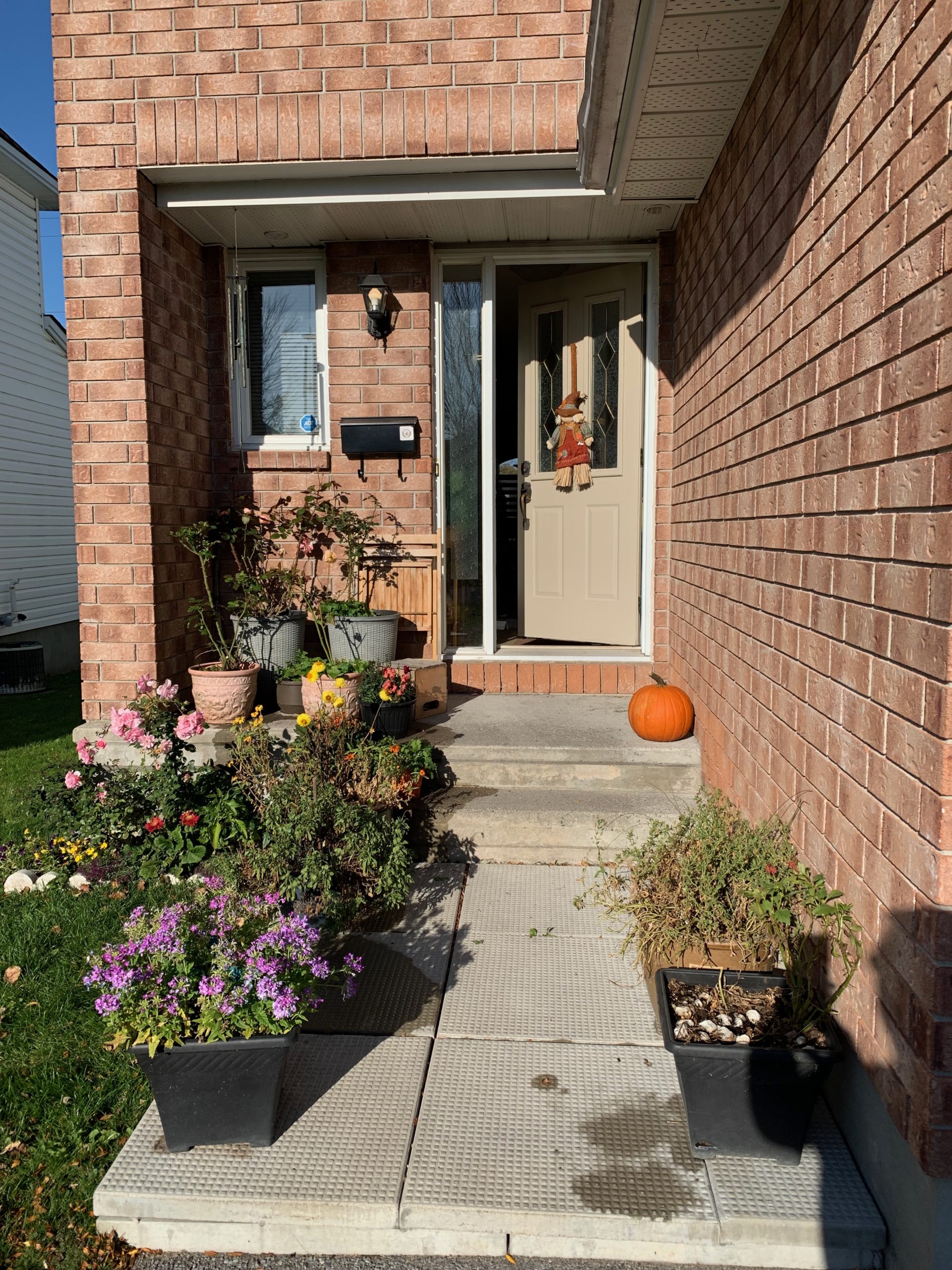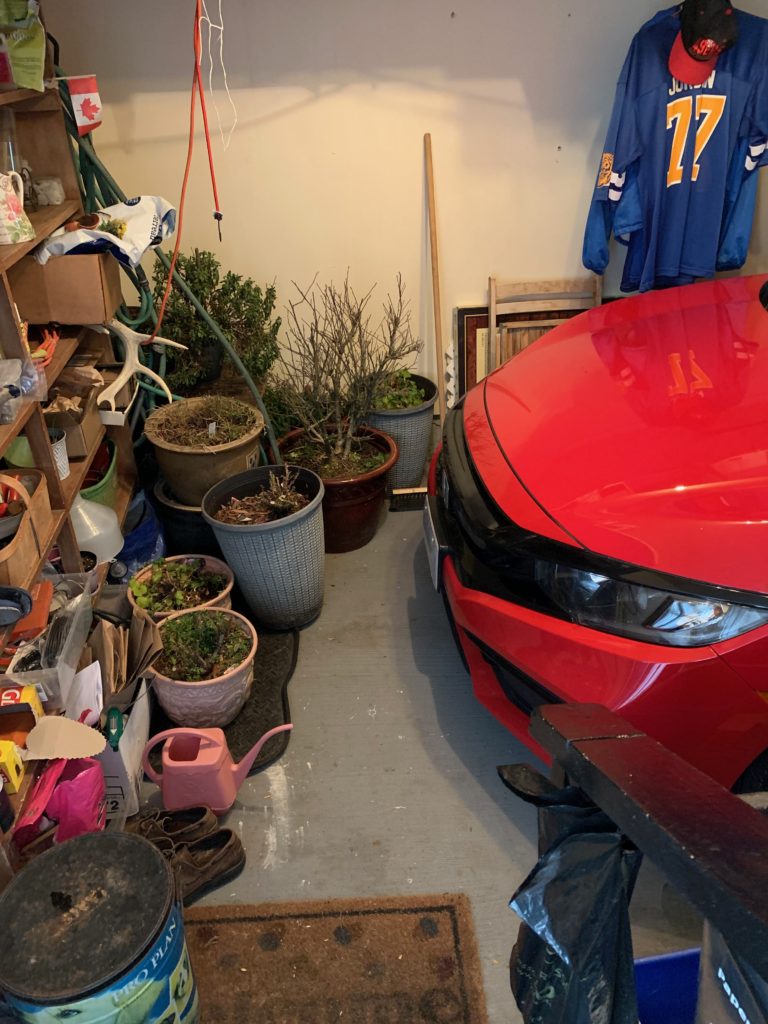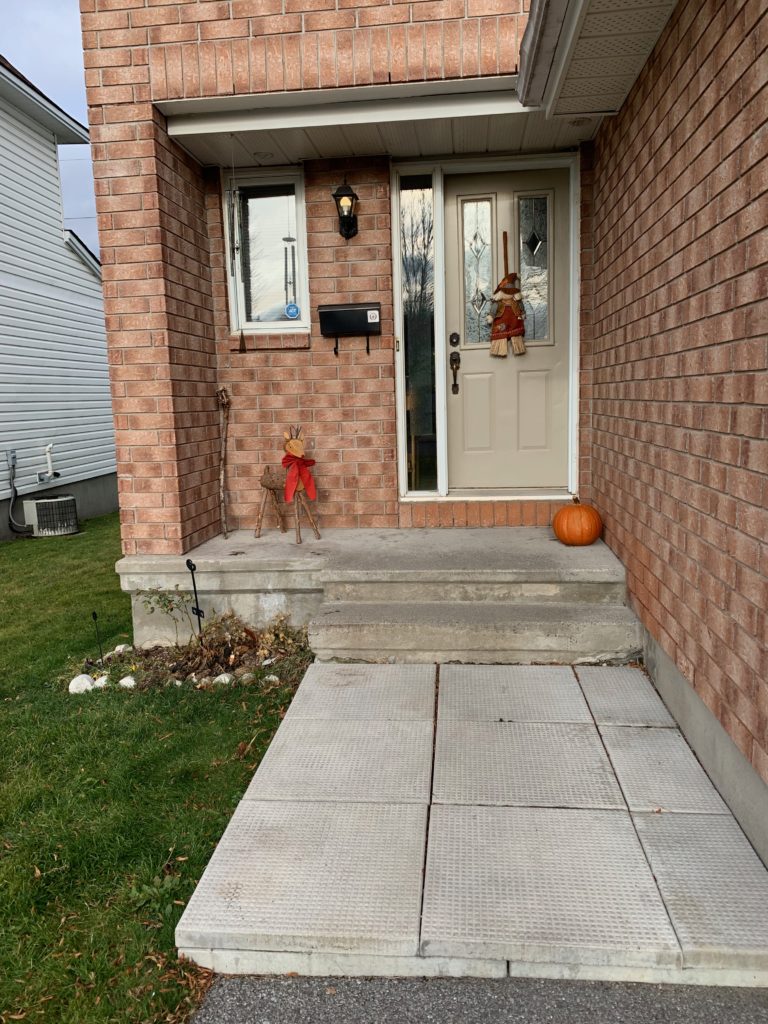I put my gardens to bed last week, and just in time too as the next day it snowed. I say gardens, but mostly they are just seven or nine large pots. My townhouse (garden home?) has a small back yard – big enough for a table and barbeque, and half a dozen pots – and a bed of Hosta growing against the wall; there’s also a tiny bed against my front porch. They are nothing like the large gardens I had, front, side and back, in my old house prior to me moving four years ago. Well, actually, some artifacts from my old garden moved with me to my new abode – the pots; and a few miniature German iris.


Putting the gardens to bed these days (and waking them up again on the spring) is a two-stage process. Both involve back breaking lifting and carrying. But that’s the thing about gardening generally – it involves back-breaking work.
The first stage entails hauling the pots from the back yard to the front porch, in the hope that we might get an autumn reprieve from frosty winter threats with an Indian Summer allowing a couple more weeks to enjoy the blooms before serious frost puts an end to such fantasies. The pots are large and heavy, laden as they are with summer rains. The distance they are to be carried is about 60 feet, though it feels like a lot more with each step.

The second stage is to finally move all the pots into the garage to overwinter there, thus ensuring the pots don’t break and the roots don’t freeze to death.

And we’re left with this barren emptiness for the remainder of dreary November and December until winter snows completely bury the memories:


The process is repeated in spring: first to the side of the house (where it’s shady) to allow the plants to awaken gradually and collect spring rains, and then a few weeks later to be lugged the remaining 50 feet to the back yard, now heavy with spring rain. By the time I’ve moved them spring and fall, my chest is heaving, my thighs are burning and my back is aching. I fear the years left to manage this task are getting fewer and fewer.
I’m not a natural gardener, but over a 35+ years span I became one, and even saw the psychological and therapeutical merits in the hobby, possibly even the fitness benefits.
Or maybe I sell myself short: maybe my Grandfather Holden’s genes forced themselves to the surface and I found my gardening interest. He was a serious gardener (actually, he was pretty serious about everything) – he used to breed daylilies to create new varietals. As a kid I remember his wonderful ornamental backyard gardens; I’m sure he must have had a sense of colour and height and seasonality – necessary knowledge if you wish to have a pleasing display of colour throughout the Ontario growing season. (Dad wasn’t much of a gardener, not much interested in gardening – he was interested in the golf links. But to be fair, he did appreciate beauty, and as an artist, he loved Monet and van Gogh’s flowered pictures, especially irises. As a result, the whole family loves irises.) Mom was an artist but gardens were not her canvas – I guess she didn’t inherit her dad’s knack for gardening; or more sensibly, she already had a back problem by the time she was 35 (car accident and resulting osteo-arthritis) and was smart enough not to aggravate an already deteriorating situation.
As it happens, my first experience with gardening within memory involve irises. It was 1963, maybe; we lived in Welland Ontario, an ancient rental house on Norway Avenue. The backyard was not much landscaped but there was a long garden dividing our lot from the neighbour, maybe 3 feet wide and 25 feet long, entirely taken up with overgrown iris and invading lawn. I don’t think it was concern for the irises so much as concern for the cluttered look of it that motivated me to clean it up. Mom advised that the iris could be dug up and the tubers split and replanted. For the next three weeks I dug up, split and separated, cleaned out unwanted grass, replanted the tubers and re-edged that garden. I was proud of my work and my young back didn’t even object, so far as I recall. Unfortunately, I never got to truly appreciate my work as the following spring we moved.
My next experience with landscaping came about in Peterborough when one of the parents realised (not sure whether Mom or Dad, but let’s give credit to Dad this time, the latent architect) that the new built house backed into the side of a fairly steep slope, and it wouldn’t take many rainfalls to see that red clay slope eventually flow into our basement. The solution: a two tiered step of landscaped barricades constructed from a couple of tons of limestone slabs. Think Machu Picchu. And who do you suppose were the conscripted slaves who wheel-barrelled the slabs from the street and up the hill to the backyard: right, Doug and brother Steve. I’m sure Dad suffered along with us but self-absorbed teenagers suffer the most. We did a fine job of it and the hill-side stayed in place, not in the basement.
My next bit of gardening was modest indeed – a little garden of tulips and petunias along the window in the south facing 25 square yard backyard of our Woodlea garden home. We lived there seven years but I never felt compelled to make further improvements on this little garden.
Gardens caught my attention though when we moved to Oakville and inherited ready-made gardens, front, side and back of our lovely big house. All I had to do was maintain it. There was a magnolia tree in the front, roses front and side, a peach tree in the back: I realised immediately this was a different growing zone than what could be found in Ottawa, not quite the banana belt but certainly temperate – I was amazed the first year we lived there enjoying roses on Christmas Day, though the next day we were buried in about three inches of ice pellets. There were ornamentals and border beds mirroring the fence, a boxed vegetable garden and a boxed raspberry garden, and ivy covering half the house; two large poplar trees in the back yard, one of which leaned at a precarious angle. It became apparent after a year of enjoying these ready-made gardens there was a lot of work required. First, the ivy had to be removed before it took over the entire house and attached garage; passage to the kitchen and to the garage was increasing difficult especially as it served as cafeteria for swarms of bees. Next the leaning tower of poplar had to come down. Regrettably, Oakville may have been more temperate than Ottawa but not temperate enough for that poor peach tree. Down it came. But the worst of it was the overgrown raspberry cane garden: I outsourced the other three projects but the raspberry canes could be removed myself. I laboured all one sunny Sunday afternoon digging and pulling and shaking out roots. It was slow and heavy going. I was dead tired but I was determined to finish the project that day. And I did. I walked exhaustively into the kitchen and reached for a bottle of beer from the fridge. As I popped the top my back went onto spasm. I leaned against counter in excruciating pain, every muscle cramping. Marlene got me to bed somehow where I stayed for two days. Even as I returned to work I was walking and sitting very gingerly. I was learning that gardening is very like other creative efforts, or as Edison famously said in a slightly different context, 1% inspiration, 99% perspiration.
We moved to Ottawa in 1987 to a custom-designed, new constructed house and there faced a completely empty canvas of back, front and side yards. I won’t recount all of those thirty years of effort but to say that they became quite wonderful in their mature state. The first project was installing two conifer trees in the back yard – and I was quite conscious of the two blue spruces Dad would have planted in his first house in 1944. Marlene was so enamoured with the boxed vegetable gardens in Oakville that a boxed garden was the next thing we constructed, this time with asparagu, not raspberry canes. When our Poodle, Winston, died in 1989 I planted two apple trees, one to mark his grave and the other to serve as a pollinator. His young nephew, Spencer destroyed both so I had to plant replacement trees the following year. The second tree grew to be the perfect climber for grandchildren, and it became Spencer’s grave marker 13 years later. It troubled me a bit to leave those two family members behind when I moved from 24 Stapledon in 2018.
My gardening days were done when I moved to the rental townhouse. I had not the energy nor the interest for ornamental gardens anymore. Nor, obviously, the space. But I did have a landscaper make some minor layout changes, front and back, laid paving stones to support seven large pots for roses, a Rose of Sharon, and a few Dahlia. But these pots resulted in the annual migration each fall and spring to the garage and back. I have not been able to completely escape the hard labour of gardening.
So what are the philosophical, psychological and therapeutic benefits of gardening: well, two actually: gardening is physical work and gives the body and mind a sense of completion and satisfaction in the immediate effect. But it also derives long term and deferred satisfaction. You plant tulip bulbs in the fall and they emerge in the spring to give you postponed pleasure; you plant roses and care and nurture them all summer, and mulch and treat them to over-winter, and they reward you by coming back each spring. This is Ecclesiastes: to everything there is a season…
I wonder how many seasons I have left. I suppose I can always conscript help wth those pots, maybe inculcate the pleasure of gardening in my grandchildren.
Doug Jordan, reporting to you from Kanata, Canada
© Douglas Jordan & AFS Publishing
All rights reserved. No part of these blogs and newsletters may be reproduced without the express permission of the author and/or the publisher, except upon payment of a small royalty, 5¢.
